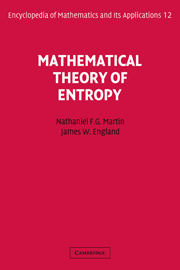Book contents
- Frontmatter
- Contents
- Editor's Statement
- Section Editor's Foreword
- Preface
- Special Symbols
- Mathematical Theory of Entropy
- Chapter 1 Topics from Probability Theory
- Chapter 2 Entropy and Information
- Chapter 3 Information Theory
- Chapter 4 Ergodic Theory
- Chapter 5 Topological Dynamics
- Chapter 6 Statistical Mechanics
- Bibliography
- Index
- About the Author
Chapter 5 - Topological Dynamics
Published online by Cambridge University Press: 05 June 2013
- Frontmatter
- Contents
- Editor's Statement
- Section Editor's Foreword
- Preface
- Special Symbols
- Mathematical Theory of Entropy
- Chapter 1 Topics from Probability Theory
- Chapter 2 Entropy and Information
- Chapter 3 Information Theory
- Chapter 4 Ergodic Theory
- Chapter 5 Topological Dynamics
- Chapter 6 Statistical Mechanics
- Bibliography
- Index
- About the Author
Summary
Introduction
Topological dynamics has its origin in the famous work of Poincaré [118] on the qualitative or geometric theory of ordinary differential equations. In Poincaré's work one finds many of the fundamental ideas and concepts of the modern theory of dynamical systems. The ideas were formalized and extended by Birkhoff [19], who undertook the systematic development of the theory of dynamical systems. The dynamical systems studied by Poincaré and Birkhoff, now called classical systems, are those that are defined from an ordinary differential equation defined on an open set or manifold contained in Euclidean n-space. In particular the second example mentioned in Section 2.8 and the example in Section 4.1 are of this type.
Specifically, a dynamical system is defined from an ordinary differential equation ẋ = H(x), where H is any smooth vector field on a smooth manifold M contained in Rn, in the following way. The fundamental existence and uniqueness theorem implies that for each p ∈ M there exists an open interval Ip of the reals R, which contains zero and a unique function Fp: Ip → M such that Fp(0) = p and for each Ip, F′p(t) = H(Fp(t)). If M is compact, then for each p ∈ M we may take Ip to be R and define a function ψ: M × R → M by ψ (p, t) = Fp(t). The function ψ turns out to be smooth because of theorems concerning the dependence of solutions on “initial conditions.”
- Type
- Chapter
- Information
- Mathematical Theory of Entropy , pp. 213 - 228Publisher: Cambridge University PressPrint publication year: 1984



